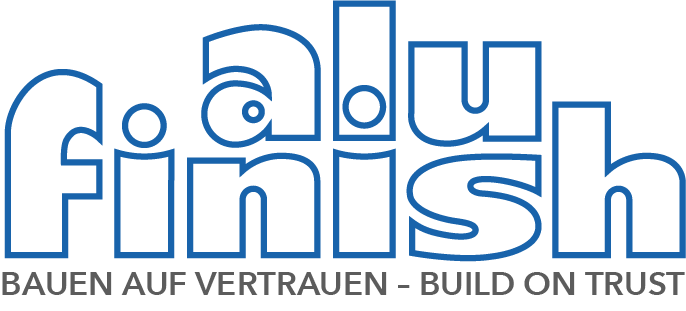A significant advantage of powder-coated aluminium surfaces is that, compared to anodised components in the architectural sector, a great many colour variations are possible. This is certainly one of the reasons why initial efforts were made in this area as early as the end of the 1960s. Just think of the pure white facade surfaces, which are still impossible to realise with an anodising process. At the beginning of the 70s, the development of the powder guns necessary for application followed.
Today, powder coating has become fully established alongside the anodising process, and you can find more or less coloured examples everywhere in architecture.
If you look at the necessary chemical pretreatment processes, they are reduced to purely functional properties compared to anodising, which also means a cost saving. However, for special projects (example: indoor pool construction), an anodisation process (so called pre-anodisation) is often used before powder coating in order to achieve a particularly high protective effect in an aggressive atmosphere. This pretreatment process is then correspondingly more cost-intensive. Apart from transparent lacquered surfaces (clear coat), the appearance of the component is not determined by the pretreatment but by the powder coating applied. Here, many variations in colour, feel and structure are possible. The chemical pretreatment therefore concentrates on good adhesion and sufficient corrosion protection in combination with the applied powder coating. After all, nothing of the pre-treated surface will be visible on the finished part later.
The chemical pretreatment
What does a typical chemical pretreatment for powder coating of aluminium components look like?
This is based both on the existing plant conditions of the respective coating company and on the desired protective effect of the final surface. In practice, chemical pretreatment is usually carried out in spraying and immersion plants, but special application methods are also used. Depending on the condition of the aluminium material to be treated, it may also have to be mechanically processed beforehand (e.g. by grinding) in order to remove stubborn surface defects (e.g. severe pre-corrosion). The first step in chemical pretreatment is always the cleaning of the respective surface. In most cases, this is carried out directly in combination with an etching process and is then defined as degreasing + etching.
Here are a few typical process sequences with Alufinish product examples (rinsing processes not taken into account):

1 – degreasing and etching separately
With this combination, you get homogeneous-looking aluminium surfaces because you first clean and then pickle. This variant is suitable, for example, for an application with transparent powder coating where the metal surface can still be seen through the powder coating.

2 – degreasing + etching in only one process step
This very reduced form of chemical pretreatment also means a certain limitation in cleaning and pickling certain (e.g. resinified) aluminium surfaces in only one process step. The possibilities for variation (focus on cleaning or pickling) are very limited here. After the pickling degreasing process, depending on the surface contamination, it is also possible to obtain a certain surface structure, which is, however, later covered by the coloured powder coating and thus does not interfere with the finished part.

3 – degreasing + etching with an additional etching process
A process sequence in this form allows flexible chemical pretreatment for different surfaces. Variations are possible in the first as well as in the second pickling zone. However, the additional process stage also requires the corresponding space in the plant.

4 – pre-anodisation process
This time-consuming and cost-intensive pretreatment process requires an existing anodising bath. At the same time, it guarantees excellent corrosion protection due to the μm-thick protective layer. After pre-anodising, special products such as the ENVIROX PREANO process can be used to optimise the adhesion of the lacquer to the porous layer. In combination with powder coating, this process is therefore particularly suitable for difficult requirements (indoor pool atmosphere, sea climate).
Corrosion protection processes today:
The chromating processes that used to be very common (yellow chromating, green chromating, transparent chromating) have been replaced more and more by alternative, chromium(VI)- or completely chromium-free processes in the last 20 years. Extensive restrictions and bans imposed by the automotive and electrical industries, as well as REACH, have also contributed to a sharp decline in chromating processes, especially in Europe. Today, corrosion protection processes based on titanium, zirconium and/or organic polymer compounds are mostly used. Numerous alternative processes have already proven their efficiency in the last 20 years (e.g. the ENVIROX NR process from Alufinish, which was developed at the end of the 1990s). Quality associations such as Qualicoat and GSB International also test these processes before they can be used in coating operations and are granted official approval. These processes are then also tested during the annual routine inspections of the coating companies.
Today, chrome-free, powder-coated surfaces have a large market share in the field of architectural applications. Powder coating systems with a wide range of properties in combination with tested, chrome-free corrosion protection processes also offer flexible and safe design options for builders and architects.
